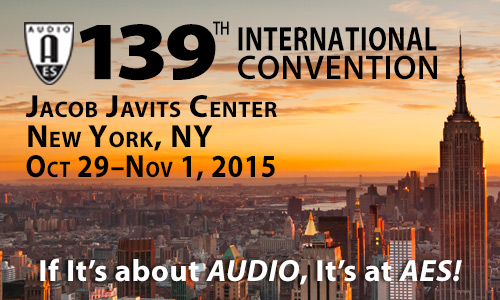
AES New York 2015
Paper Session P22
Sunday, November 1, 2:00 pm — 4:00 pm (Room 1A08)
Paper Session: P22 - Sound Reinforcement
Chair:
Peter Mapp, Peter Mapp Associates - Colchester, Essex, UK
P22-1 From Studio to Stage—Guillaume Le Hénaff, Conservatory of Paris - Paris, France
To convert studio produced music into a live concert is a key issue for a lot of artists. Studio work is often a long-term undertaking during which everything is subject to attentive decisions, e.g., instruments, performers, recording venues, microphones. When performing songs from a record in concert, all these decisions have to be reviewed or at least questioned. Indeed, studio and stage are two really different production contexts and differ on so many points that artists often change their arrangements, line-up or even the form of their songs. However, live sound engineers may be expected to reproduce the sound quality and aesthetics of the record. In this paper we propose solutions regarding the switchover from studio to stage to provide artists and engineers with useful tools when designing the sound of a studio album-inspired live show. Specifically, we explain why and how performing music is different in concert than in studio, we detail types of microphones that are suited to both recording and sound reinforcement applications and we take an inventory of miking tricks and mixing techniques like Virtual Soundcheck that offer a studio workflow to Front of House engineers.
Convention Paper 9476 (Purchase now)
P22-2 Some Effects of Speech Signal Characteristics on PA System Performance and Design—Peter Mapp, Peter Mapp Associates - Colchester, Essex, UK
Although the characteristics of speech signals have been extensively studied for more than 90 years, going back to the work of Harvey Fletcher and Bell Labs pioneering research, the characteristics of speech are not as well understood by the PA and sound reinforcement industries as they perhaps should be. Significant differences occur in both the literature and between international standards concerning such basic parameters as speech spectra and level. The paper reviews the primary characteristics of speech of relevance to sound systems design and shows how differences within the data or misapplication of it can lead to impairment of system performance and potential loss of intelligibility. The implications for compliance with various National and International Life Safety standards are discussed.
Convention Paper 9477 (Purchase now)
P22-3 Directivity-Customizable Loudspeaker Arrays Using Constant-Beamwidth Transducer (CBT) Overlapped Shading—Xuelei Feng, Nanjing University - Nanjing, Jiangsu, China; Yong Shen, Nanjing University - Nanjing, Jiangsu Province, China; D.B. (Don) Keele, Jr., DBK Associates and Labs - Bloomington, IN, USA; Jie Xia, Nanjing University - Nanjing, China
In this work a multiple constant-beamwidth transducer (Multi-CBT) loudspeaker array is proposed that is constructed by applying multiple overlapping CBT Legendre shadings to a circular-arc or straight-line delay-curved multi-acoustic-source array. Because it has been proved theoretically and experimentally that the CBT array provides constant broadband directivity behavior with nearly no side lobes, the Multi-CBT array can provide a directivity-customizable sound field with frequency-independent element weights by sampling and reconstructing the targeted directivity pattern. Various circularly curved Multi-CBT arrays and straight-line, delay-curved Multi-CBT arrays are analyzed in several application examples that are based on providing constant Sound Pressure Level (SPL) on a seating plane, and their performance capabilities are verified. The power of the method lies in the fact only a few easily-adjustable real-valued element weights completely control the shape of the polar pattern that makes matching the polar shape to a specific seating plane very easy. The results indicate that the desired directivity patterns can indeed be achieved.
Convention Paper 9478 (Purchase now)
P22-4 A Novel Approach to Large-Scale Sound Reinforcement Systems—Mario Di Cola, Audio Labs Systems - Casoli (CH), Italy; Alessandro Tatini, K-Array S.r.l. - Florence, Italy
An innovative approach to vertical array technology in large-scale sound reinforcement is presented. The innovation introduced consists in mechanical arrangement of the array as well as DSP processing for computer assisted coverage optimization. Beyond these innovations, a different form factor of the vertical array elements and the unusual acoustic principle of dipole are also involved as well as an alternative mechanical aiming method. The paper presents a synthesis of this innovative concept supported by detailed descriptions, test measurement results and proven results from real world applications that have been done.
Convention Paper 9479 (Purchase now)
